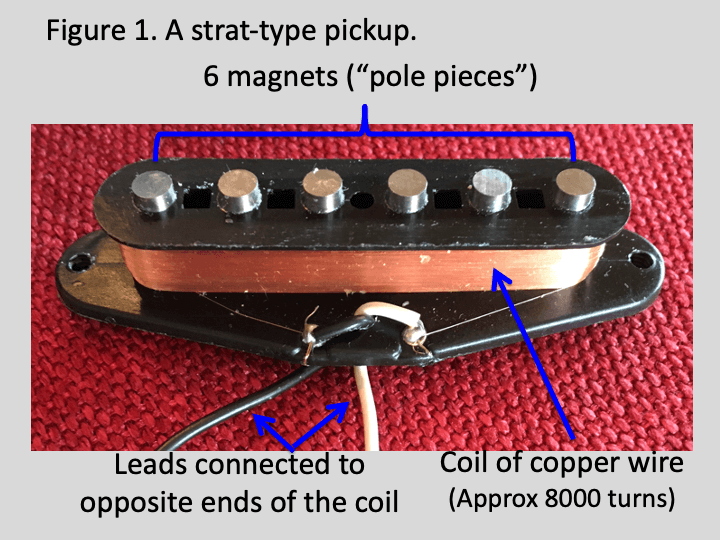We are going to post a couple articles wherein we discuss how guitar knobs work. The volume and tone controls overlap in terms of principles and electronic components, but there are some important differences. We will start by discussing volume and tone controls as implemented in guitar circuits. Then we will give some examples of how they work in amplifiers, where the basic principles are the same.
Let’s start this discussion with a simple reminder of what an electric guitar pickup does. In simplest terms, the vibrating metal string near a guitar pickup sets up an alternating (AC) voltage across the two leads of the pickup. Surprisingly, the nitty-gritty physics of how a guitar pickup does this is actually something of a debate. However, the basic idea behind how this happens is not a matter of debate. Namely, an electromagnetic field can be used to create a charge separation (voltage) in a wire that is moved through that field, which in turn can cause current to flow through the wire.
Of course, the converse is also true: a magnet moved near a wire will cause a charge to build up in the wire.
The basic guitar pickup contains magnets (the “pole” pieces) surrounded by a coil of wire. When a string vibrates rapidly near one of the magnets the fluctuations in the magnetic field create a charge in the windings of the coil. There is some debate over whether the role of the string is to create disturbances in the static magnetic field of the magnets or, instead, the string actually becomes magnetized from the magnets in the pickup, thereby becoming a moving magnet that in turn induces a charge across the coil. A third theory suggests the truth is somewhere in between.


An important point about terminology: In electrical circuits, current refers to the movement of charges, whereas voltage refers to the potential to create current. Current is analogous to the movement of water through a pipe. In this analogy, voltage is analogous to static water pressure. Voltage is therefore a form of potential energy, while current is the movement of charges through a conductor in response to that potential energy.
Although the abbreviation “AC” is literally derived from the term “alternating current” the abbreviation is also used to describe alternating charges (AC voltage) independent of current flow. Hence, for example, a vibrating string can set up an AC voltage across the terminal wires of a guitar pickup independent of how much current is flowing from that pickup to an amplifier.
AC voltage and current are often illustrated by a figure depicting a sine wave. The figure shown below shows two full cycles of AC voltage. As a comparison, the open G string on a guitar with standard tuning would generate 196 full AC cycles per second.

There is of course another form of voltage and current represented by the abbreviation “DC” (from direct current). DC voltage is the type presented to a circuit by a battery (for example). The polarity is constant. DC voltage and current are critically important in electronic devices, but it is not relevant to the immediate discussion. In a graph of the type shown in Fig. 2 DC voltage would be shown and a straight horizontal line.
In the next article, we’ll talk about potentiometers and capacitors as part of our “how guitar tone and volume controls work” series.
In the meantime, if you’re looking for the best online audio store for tubes, vintage amps, and more, please be sure to visit our shop!